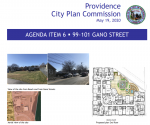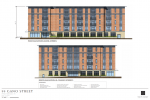There's no ROW available. The Warren Branch is obliterated after the state line by the entire Ocean Grove neighborhood of Swansea that built over it post-abandonment. And any/all attempts to try to find a graft-on trajectory to I-195 become an exercise in futility with all the wetlands, ocean inlets, and wretched insertion-angle geometry to contend with. Of all the Crazy Transit Pitches wishlist items that can be quantified with some tangible demand, this may be the most real-world physically impossible of the whole lot. Which is really saying something given the proposals we regularly toss around here.
Unfortunately when the line was in-service it was handicapped by the extreme weight-restricted rail upper deck of the Slades Ferry Bridge, which could only take the wood-bodied ultralight interurban-like EMU's that the Old Colony ran captive to East Providence electric territory and not any type of standard RR equipment. All the steam trains hauling New York weekenders to Newport had to go the long way Providence-Attleboro-Taunton-Fall River, and no freight could ever cross the bridge. It was basically relegated to "the last unicorn" status of the whole pan-NYNH&H system equipment-wise, propped up through the 1920's only by pretty strong ridership. When the Great Depression wiped out the railroad's finances and hit ridership hard they had to immediately curtail the commuter-oriented EMU service to save money, leaving literal zero other traffic they were capable of running that way. With no excuse to keep the line open, it was immediately torn up. Had the bridge been able to take something/anything of standard car weight they would've easily been able to justify keeping it open because the NY-Newport trains would still be running through the late-50's and would save loads of time this way instead of the around-the-horn routing, while many freight routings could've been consolidated out that way providing further justification for its continued existence. Alas, no one had money to replace that flimsy bridge with something better until the failing road deck got condemned in 1970 and the state demolished the whole thing for scrap sans any planned replacement. The bridge was at the rotary-to-nowhere on MA 103 a stone's throw south of the now-derelict Brightman St. bridge, and connected on the Fall River side at the Remington Ave. dead-end. Excess retaining wall weirdness on Pearce St. behind the strip mall on Davol tips off where the Warren Branch met the Newport main at the old station entrance to Fall River Depot.
It doesn't help either that the Old Colony never filled the 3800 ft. gap separating the Newport main downtown from the stub end of the Wattupa Branch @ Plymouth Ave. precluding any direct thru-route connection to New Bedford, and that by the time the I-195 canyon and New City Hall air rights went into design in the late-50's the RR was too cosmically broke and eager to dump the Old Colony commuter rail lines that it didn't/couldn't make any design stand for a ROW reservation in the new expressway cut completing the missing link at long last (if for no other reason than freight-usefulness). By the time the first short segment of 195 opened downtown in '63 commuter rail to the South Coast had already been gone 5 years.
---- ---- ---- ----
In a parallel universe where the Slades Ferry Bridge wasn't such an achilles heel, you'd probably see the South Coast rail lines consolidated into something more like this:
We don't live in a parallel universe, however, so all these pegs knocked out between 1938-1958 are utterly, totally nuked of any possibility of reconnection.
- fully preserved Warren Branch, and even if the East Providence tunnel still closed in '81 all the same at least some east-side freight out of Pawtucket still coming that way.
- a Wattupa Branch that fully spanned the whole way from Fall River to New Bedford, acting as primary freight lane between both ports to this day.
- a different Depression-era consolidation of the routes from Boston. As is, the Somerset Branch (a.k.a. south extension of the Stoughton Line straight out of Taunton) got truncated despite originally being the preferred passenger route so they could save coin retiring the Mallard Point drawbridge. Traffic got re-routed further east onto the *current* Fall River Branch (a.k.a. ex- Lakeville Branch) through barren Freetown State Forest at slight schedule penalty but much much easier maint costs and no drawbridges. Somerset Branch is full MassDOT-landbanked to within 1 mile of Mallard Point because it stayed in various states of use/semi-disuse until the 1980's, but the mile to the old draw is completely and utterly obliterated by rich housing. In the parallel universe where the Warren Branch stayed and crossed a newer/better bridge, they would've seen fit to re-route the Somerset Branch west of Somerset Reservoir for a few miles through (then) farmland along Route 138 to junction with the Warren Branch at a consolidated crossing. That is: all Boston OR Providence traffic crosses the river at the same place, and service to New Bedford vs. Newport branches at Fall River Depot dead-center downtown instead of way the hell out in Myricks.
- Lakeville Branch (current route) in the forest between Myricks and FR Depot gets abandoned instead. New Bedford Branch (a.k.a. Old Colony mainline to Lowell) north of the airport probably stays after the dust settles as a secondary freight connector for the still present-day critical yards at Framingham and Middleboro...but never catches a whiff of passenger interest ever again because the FR Depot hub + Wattupa Branch are so much superior for pooling/distributing.
Thank you, as always, very helpful summary!




